Sapa is a mountainous town surrounded by many hill tribe villages, beautiful terraced rice fields, and Fansipan - the highest peak in Indochina. To discover the best of town and its surroundings, take a Sapa trekking trip.
During your trekking in Sapa, you can navigate through mountain paths to witness one of the most beautiful rice fields in Vietnam and lush green natural landscapes. Over the time of year, these picturesque rice fields change from green to yellow. Along the way, you will pass rustic hill villages of distinct ethnic minorities, where you can get away from the city's hustle and bustle. In Sapa, Hmong people, Dao people as well as other ethnic groups still wear their traditional clothes, even when they are working on the fields. It is also possible to see a few water buffalo ridden by local children.
With such unique features, Sapa is a wonderful place to learn about unique cultures and take great photos. Read on this guide to the best trekking in Sapa to learn about the best time to visit, some of the most nice trekking routes, where to stay and what to prepare!
1. Best time to go trekking in Sapa
Located on the side of the massive Hoang Lien Son Mountain range (Northwest Vietnam), Sapa has cool to cold weather all year round, with some points to very low temperatures.
Travelers can go trekking in Sapa all year round, depending on the time and season you would like to start your journey. To find a suitable time for you, let’s see what each season will offer you.
March to May: It comes with cool weather and lots of sunshine. Natural flowers bloom and plants grow. Sometimes it rains but the volume is very low. You are still able to walk through the rice terraces without difficulties
June to August: This is summer time in Sapa and also the rainy season. The temperature fluctuates around 25-30oC. The shower often suddenly comes to cool down the atmosphere and quickly evaporates, leaving a trail dry. The rays of sunshine are bright, making it a good time for taking pictures.
September to November: Sapa weather is stable when it’s sunny during the day and cold at night and early in the morning. This makes September to the end of November the most ideal time to trek and hike in Sapa. You are free to choose a trekking tour based on your ability. As the sun shines quite a lot during these months, the trails are dry that help you have strong steps.
December to February: Although there is just a little rain, most of the time it’s foggy. The path may be a bit muddy and slippery. You should prepare good trekking shoes as well as have a local tour guide accompany you and take you to the most safe and easy trail.

Ta Van Village, Sapa
Besides, August and September are months of the green terraced rice fields turning yellow, which are in full splendour. Families will take turns to harvest rice. Depending on the different planting time of the different villages, the harvest time will also be varied. To be sure that you encounter some of the best rice terraces, you should ask the locals before going if the area you are trekking has been harvested or not.
2. The Most Noteworthy Sapa trekking routes
Now you know the suitable time to go trekking in Sapa, we will suggest some of the most favourite trekking routes for you to choose.
Firstly, choose the duration of your trekking trip. Most trekking lovers agree that the ideal duration for a Sapa trip is 3 days and 2 nights because the further you go, the less touristic the area that you reach. However, if you don’t have much time, 2 days and 1 night should be the minimum. At the end of day one, you are able to overnight in an authentic homestay. If you go trekking in Sapa for one day, you will enjoy seeing only a part of the terraced fields and a local village, which is the favourite option for those with less endurance.
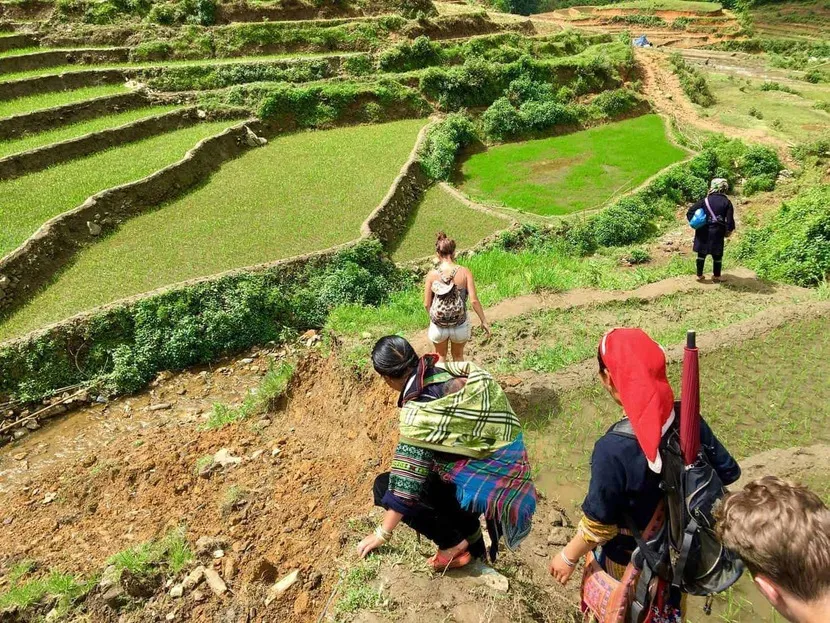
Keep reading to find out the most significant Sapa trekking routes that require easy to moderate physical condition.
2.1. Y Linh Ho - Lao Chai - Ta Van
When you go trekking through Y Linh Ho village, Lao Chai village and Ta Van village within 1 day, you will experience around 10km to enjoy the scenery of terraced fields, meet young boys and girls in the villages.
Starting from Sapa, you will walk about 6km down southeast of town along Muong Hoa valley to Y Linh Ho village, enjoy the view and have lunch with the locals.
Y Linh Ho village, located in San Sa Ho commune (Sa Pa), is divided into 2 villages: Y Linh Ho 1 and Y Linh Ho 2. Each village has about 100 households. Local people mainly do agricultural jobs, cultivating rice and maize. Y Linh Ho village is located far from the main road. The road to the village is quite rugged and winding, so Y Linh Ho is different from other villages in which it has no noise of traffic, but only has the peaceful and quiet scenery.
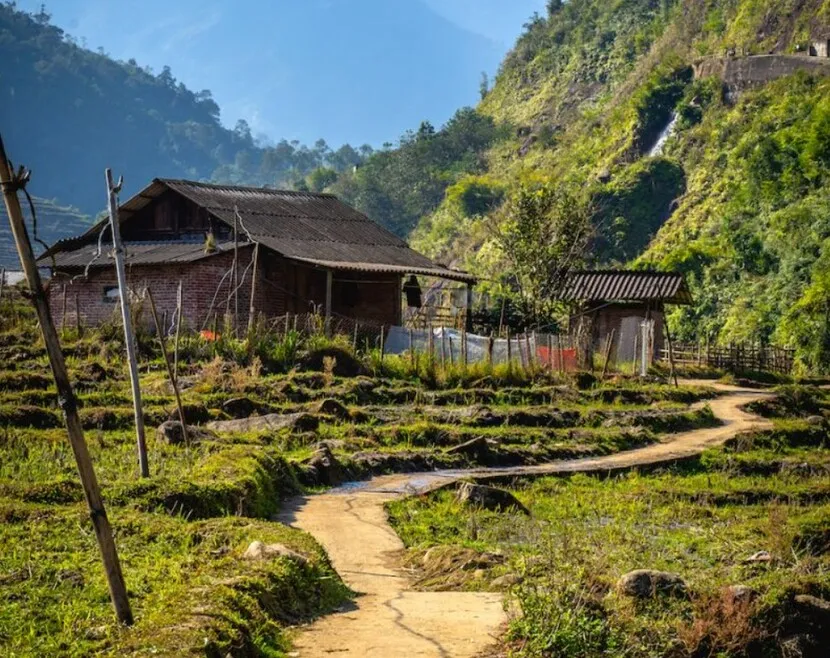
Lao Chai village (Sapa) trek path
Leaving Y Linh Ho village, going another 2km, you will reach Lao Chai village, through terraced rice fields, you will reach Ta Van village of the Giay ethnic people. Lao Chai - Ta Van village is located in the valley, flanked by two majestic Hoang Lien Son and Ham Rong mountain ranges, surrounded by terraced rice fields at a lower level. The terraced fields in Lao Chai have existed for hundreds of years and are created by diligent hands of ethnic minority farmers. The terraced fields even extend to the door of the house.
Besides the spectacular scenery, trekking in route Y Linh Ho - Lao Chai - Ta Van you will have the opportunity to learn about the daily life and cultural features, customs and habits of at least 3 ethnic groups. Experiencing the local culture, we cannot miss the local dishes. Vegetables, pigs and chickens are made by locals from farm to table. Though just simple dishes, they have their own unique flavour thanks to the mountain spices.
Note: Going down the valley by car/motorbike is possible. Then you can have a short walk to visit some villages and have lunch with a local family.
- Distance: 10km
- Level: Easy trekking
- Highlights: Hmong culture, Giay culture, close look at beautiful rice terraces, overview from high level to rice valley
Admire the majestic beauty of Y Linh Ho from above
2.2. Ma Tra - Ta Phin
Ma Tra and Ta Phin are 2 villages inhabited by the H'Mong and Red Dao people, located not far from Sapa town centre. The travel route between these two villages is only about 7 km, but it boasts an extremely majestic and charming natural landscape.
Apart from the natural scenes, when coming to Ma Tra and Ta Phin, visitors also experience daily life as well as the unique cultural features of the two hill tribes.
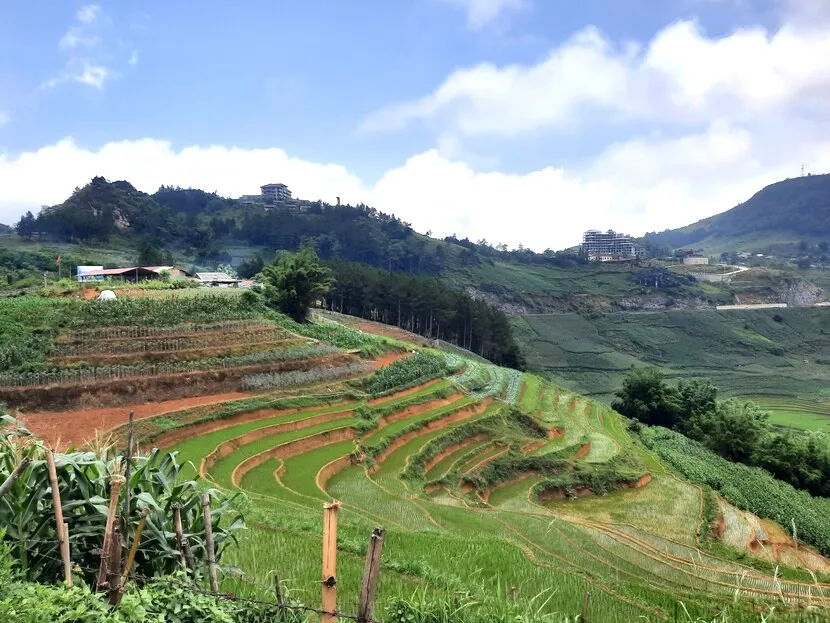
Hiking route: Ta Phin Village, Sapa
Starting the tour, you are transferred by car to Ma Tra village - where the H’mong ethnic community are living. Here, you will be able to observe the daily life and work of the H'Mong people. You’ll get more out of your visit to Ma Tra - Ta Phin with a tour guide, who will speak English and be able to offer you insights into the unique customs and cultural practices of the local ethnic minorities. Begin a trekking journey of about 7km, trekking from Ma Tra village to Ta Phin village. The trail is paved and quite flat, hence it is very convenient to move on, without any danger or obstacles.
Going along the paths from Ma Tra to Ta Phin, you will have the opportunity to see the wonderful beauty from the unique terraced fields manmade by the H'Mong and Red Dao ethnic groups. Depending on the time of year, these fields are covered with different vivid colours. In addition to terraced fields, along this road, there are also immense corn fields and countless fruit trees such as peaches, pears and plums. Arriving in Ta Phin village, visitors can take a break before continuing to explore Dao people’s daily life. Enjoy a late lunch with a local family or in a famous restaurant in the village centre.
- Distance: 12km
- Level: Easy trekking
- Highlights: Hmong culture, Dao culture, easy path, corn field and terraced rice paddy, Ta Phin village
2.3. Suoi Ho - Ta Phin
From Suoi Ho street, Sapa town, you will start walking along the road down to the valley. Initially, the trail features hundred concrete steps and is easy to walk, then you will go through more rugged trails and narrow paths through the village, the green vegetable fields. Here you have the opportunity to meet and interact with lots of local ethnic minorities.
After half an hour, you will reach Suoi Ho Bridge. Go ahead or turn left along the steep slope to cross Ta Phin village, on the way you will meet no or very few tourists like you, this authentic trail is for you to explore. A craggy stream awaits you to cross. You will pass through Suoi Ho village and a few hamlets of Sa Pa commune in 2 hours, passing a few Hmong hamlets scattered on the hillside. On the way, you are able to stop to visit Ta Phin Monastery.
Continue trekking Sapa tour along the trail about 4km and downhill towards Ta Phin Valley. Coming to the centre of Ta Phin commune, you will have time to leisurely walk around this beautiful valley.
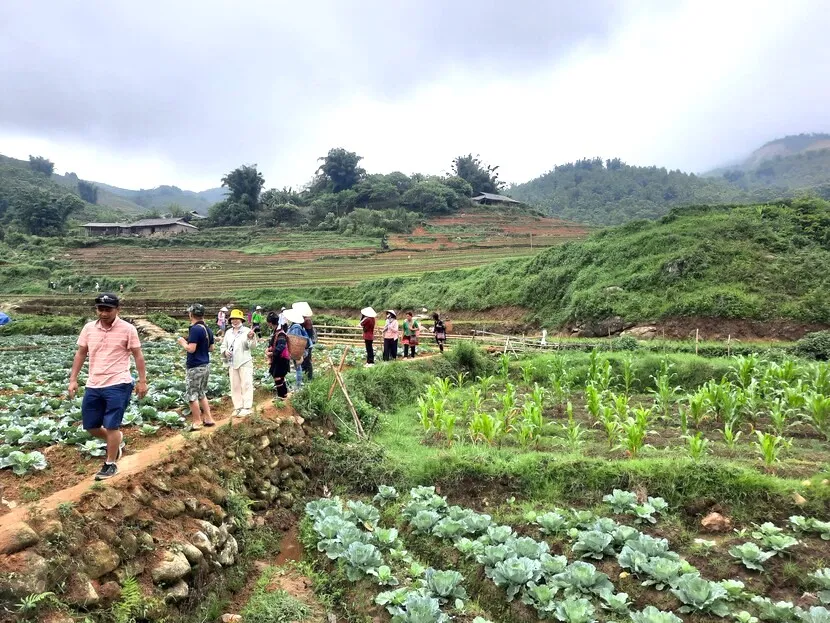
Trekking with IZITOUR through Suoi Ho village, Sapa
Ta Phin Center has many homestays for you to stay overnight. Local restaurants are also ready to serve you a variety of unique specialties.
To learn more about Ta Phin, see this article: Ta Phin Village - A Rustic Charm among Sapa Mountains
- Distance: 12km
- Level: Moderate trekking
- Highlights: Hmong culture, Dao culture, authentic trekking trails, terraced rice paddy, countryside local hamlets, Ta Phin village
2.4. Ban Khoang - Ta Giang Phinh
Ban Khoang and Ta Giang Phinh village are inhabited by Black H'Mong and Red Dao ethnic minorities. They still maintain their traditional custom and their unique way of life. Therefore, embarking on Ban Khoang - Ta Giang Phinh trekking route, you will have an opportunity to experience the authentic ethnic culture, local daily life and enjoy the wonderful landscape of vegetation, waterfall, and terraced rice fields.

One of the best hikes in Sapa
You will start from your hotel in Sapa, take a short car transfer heading northwards of Sapa along national road 4C to O Quy Ho Pass. On the route, there will be several stops for stunning landscapes of Fansipan mountain, Sin Chai valley and vegetable farms. Continue to follow a narrow road for half an hour, getting through the wild region with thick rain-forest covering walled-up mountains before reaching Ban Khoang.
From afar, the village looks like a village in a fairy tale with cardamom grown under the forest trees' shade. People cultivate wet rice on terraced fields. Upon arrival, spend over 1 hour walking around to explore the Ban Khoang village.
Leaving Ban Khoang, you will continue your trekking route of about 10km to Ta Giang Phinh valley, where Black H'mong ethnic minorities are living. Enjoy a lunch break among peaceful and fresh atmosphere then follow the paths connecting hidden hill villages. You can expect to see H'mong people working on fields or doing housework. Besides cultivation, H'mong women are skillful at brocade weaving. Meanwhile, H'mong men do heavier work like repairing houses or other items.
If you would like to explore untouched lands, Ta Giang Phinh is a promising destination for your upcoming journey. Not too many tourists means that you can enjoy a unique experience that not everyone has.
- Distance: 11km
- Level: Moderate trekking
- Highlights: Hmong culture, Red Dao culture, untouched scenery, Ta Giang Phinh terraced field, Ngu Chi Son mountain view
2.5. Tram Ton Pass - Silver Waterfall - Sin Chai village
From Sapa centre, you will be transferred to Tram Ton Pass on a winding road of stunning Hoang Lien Son mountain views. Enjoy the beautiful landscape of mountains and valleys.
The first stop is Silver Waterfall, which is the largest waterfall in Sapa. Walk up 200 steps and cross the bridge to get a better view of the surrounding scenery, enjoying the view.
Then go trekking downhill through thick forest to Sin Chai village which is home to more than 60 Black Hmong families. It’s a challenging trail, taking almost 3 hours. But your effort is worth it when you immerse yourself in the beauty of nature with amazing vegetation of flowers, vegetables, medicinal plants and rice terraces. Arriving in Sin Chai village, you will leisurely stroll and discover the culture of the Black H'Mong people who migrated to this mountainous region many centuries ago. Stop at some local house and meet friendly hosts. Differences in culture, language and way of life make this group attractive to tourists.
- Distance: 11km
- Level: Moderate trekking
- Highlights: Black Hmong culture, downhill trekking trails, majestic pass, stunning waterfall, Sin Chai village

Sin Chai valley, Sapa
With little exercise to improve your health, you totally can take one of those Sapa trekking routes. However, in case you're looking for a more challenging trekking route in Sapa, there are a few options that offer more demanding terrain and longer distances. These routes will test your endurance and require a higher level of fitness. Here are a few of stunning hard trekking routes in Sapa:
- Ban Khoang - Sa Seng
- Sa Seng village - Hang Da village
- Sau Chua village - Sa Seng village - Hau Thao village
- Ban Ho village
- Fansipan mountain - Tram Ton Pass
All of the mentioned Sapa trekking routes can be completed within one day. If you would like to have a longer trip, you can combine two or three days together to fully immerse in the breathtaking scenery and experience the local culture.
Example of 2-day Sapa trip:
Day 1: Admire the beauty of Ma Tra - Ta Phin (home to Hmong and Red Dao people)
Day 2: Exploring Y Linh Ho valley - Lao Chai village - Ta Van village on your foot>> Check the price for this Easy Sapa Private Tour from Hanoi

One of the best treks in Sapa
Example of 3-day Sapa trekking expedition:
Day 1: Half day driving from Hanoi to Sapa, half day visiting Sin Chai village
Day 2: Exploring Y Linh Ho valley - Lao Chai village - Ta Van village on your foot
Day 3: Admire the beauty of Ma Tra - Ta Phin (home to Hmong and Red Dao people)>> Check the price for 3-day Easy Discover Sapa Holiday by Private car from Hanoi
3. What to prepare for a Sapa trekking tour?
To prepare for a Sapa trekking tour, you should see the weather forecast of the season you come. No matter what, do not bring too many things with you. Pack as light as possible to make your trekking a lot more comfortable.
In summer: Comfortable clothes are strongly recommended. Because there may be occasional showers, you should bring a light raincoat to protect yourself. Fast drying clothes and swimming gears are also recommended as you could cross some stream on the way.
In winter: Waterproof jacket and jacket are recommended. It is better to wear several layers rather than a few thick warm clothing. When it gets warmer during your hike, you can take off layer by layer.
The other things considered to bring:
- Trekking shoes or boots (strongly recommend)
- Comfortable clothes
- Sunscreen
- Mosquito repellent
- Personal small water bottle
- Camera with extra batteries
- Snack
- Raincoat
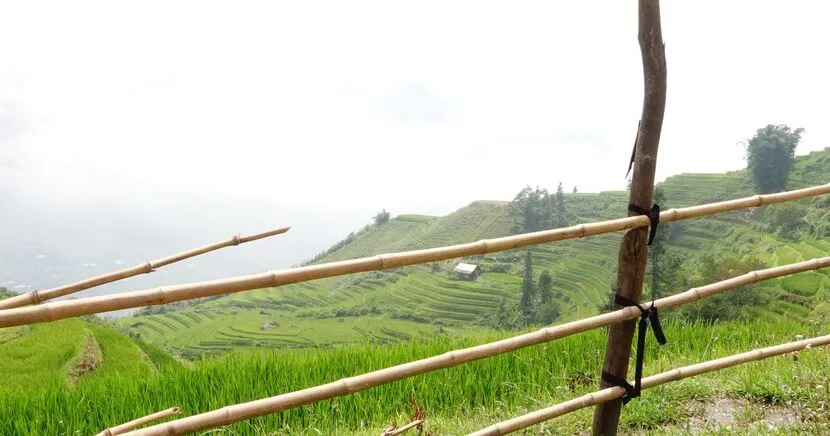
4. Accommodation during your stay
In the village centre where there are many homestays like Ta Phin Village and Ta Van Village, you can stay overnight at the local home. This allows you to engage with the locals, try traditional food, and gain insights into their way of life. The next day you are free to continue your trekking route to further destinations or go back to Sapa town. Travellers are welcome to stay over at local people’s houses.

Spend an overnight at a homestay along the Sapa trekking route
This is a favourite accommodation option for those who are looking for an authentic experience. However, some local homes may lack showers and modern toilets. If you need extra comfort, come back to Sapa town centre to stay in hotels. With this option, you still can stay for lunch at a local house and have hosting families cook good lunch for you.
5. Getting to Sapa
Normally Sapa trekking tours start from Sapa town or Hanoi, the capital city. In case your trekking tour in Sapa does not start in Hanoi, you will have to go to Sapa. There are few options to reach it.
Bus: The night bus from Hanoi to Sapa takes around 6 hours, offering you both soft seats and a soft berth. You will arrive in the early morning.
Limousine buses: This is a comfortable bus running during day and night. If you embark on an early morning bus, you will arrive around noon. It serves less travellers and picks up travellers at some certain central points.
Train: Lao Cai station is located about 30 minutes away from the town. From here, you can take a bus, taxi, or arrange a private car to pick you up. The journey takes approximately 8 hours, with most trains leaving in the evening and arriving early in the morning. The regular trains offer different types of cabins with 4 beds, 6 beds, or soft and hard seats.
Private car: This is the most favoured means of transportation for safety and speed reasons. A private car is the optimal choice for families with kids.
>> See more: How to get from Hanoi to Sapa?
While many mountain roads are rugged and filled with people, there are still countless authentic trails for us to step on. Therefore, many people choose trekking tours to enjoy the gorgeous scenery of Sapa fully. Join us in a Sapa trekking tour to discover Sapa regions in the best way. To get a personalized Sapa trip itinerary, contact us via email [email protected] or visit our tour package to check and book at the best price.
See more:

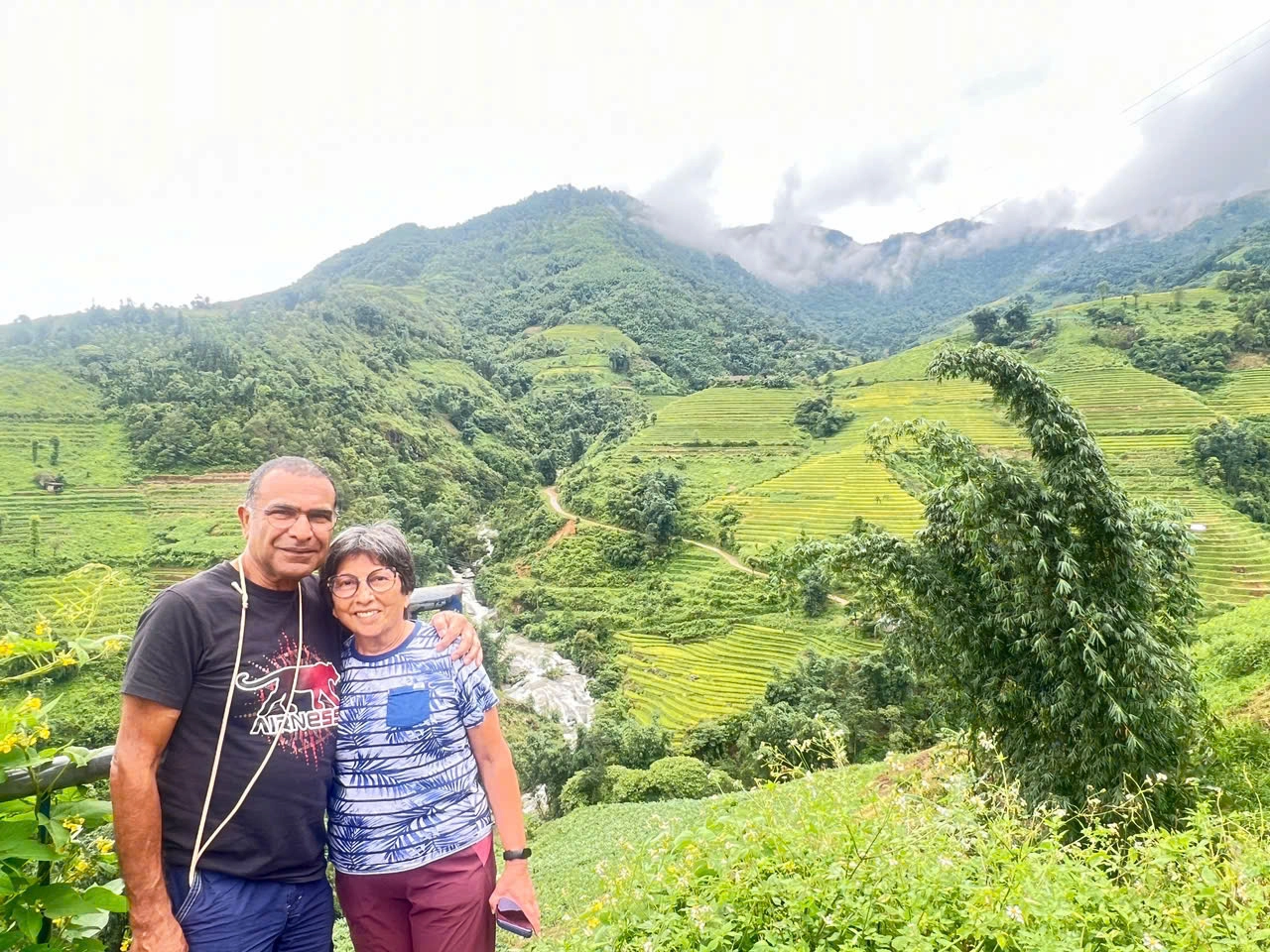
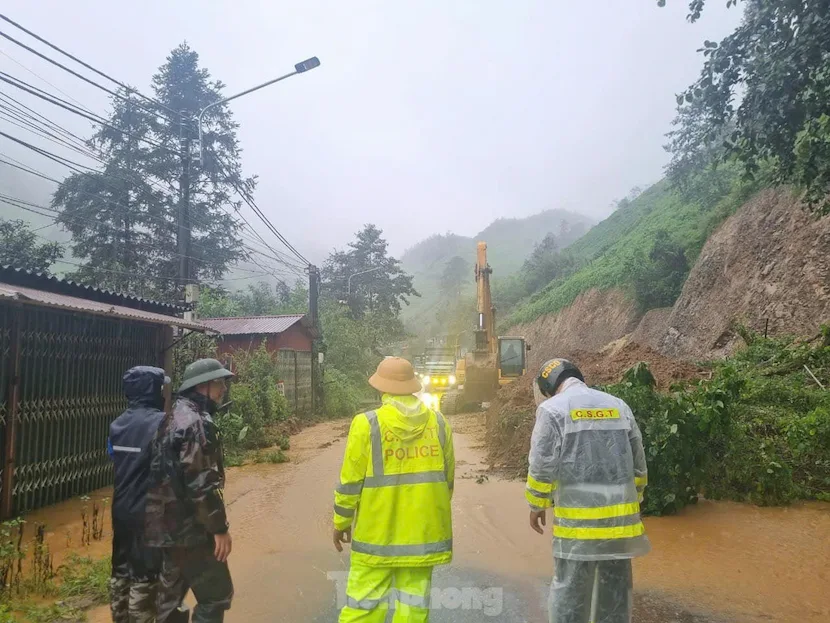
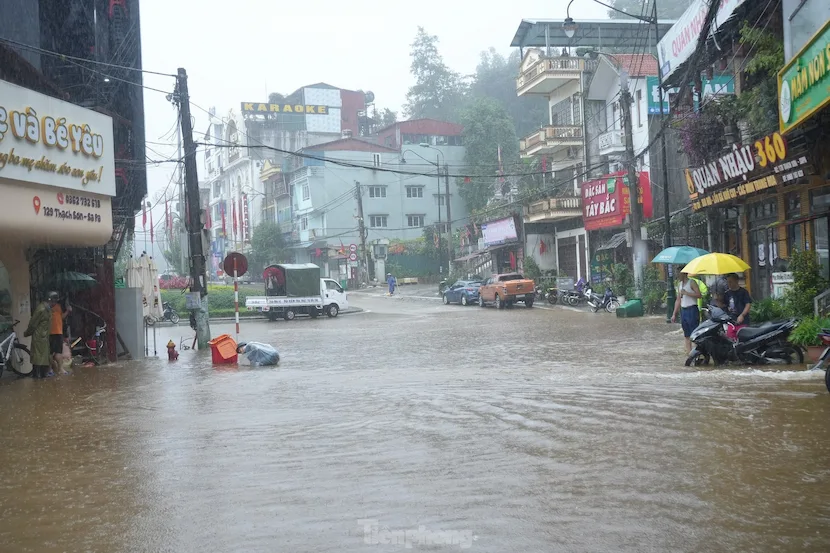







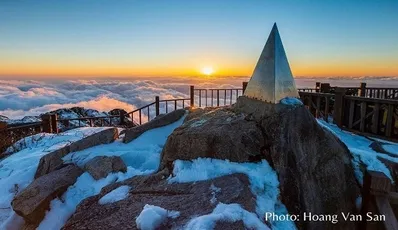
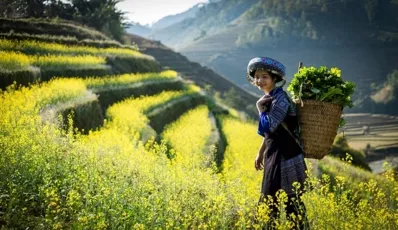
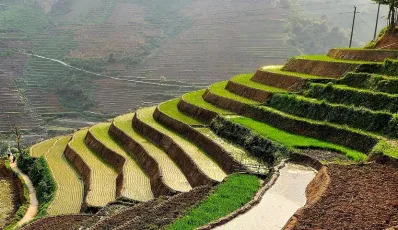
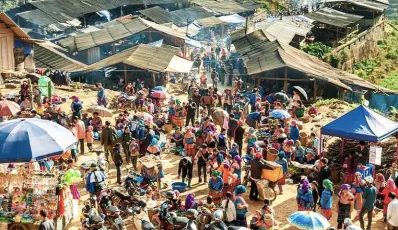
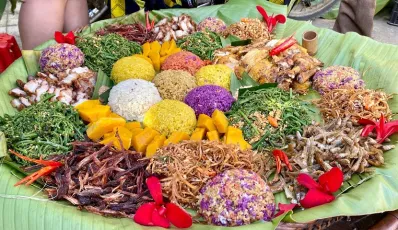
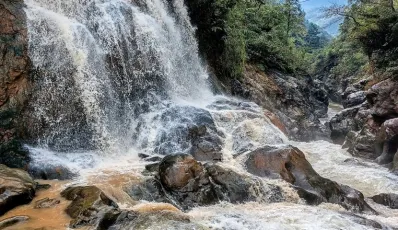
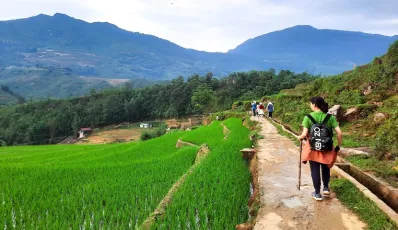
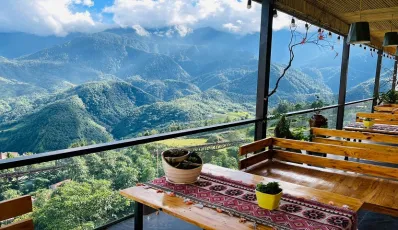
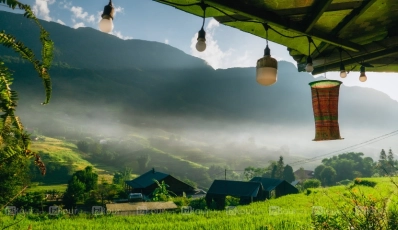




 TRAVELERS' CHOICE 2025
TRAVELERS' CHOICE 2025 



13 Comments
France
Vietnam
La meilleure période pour admirer les rizières en terrasses de Sapa dans toute leur splendeur s'étend de fin août à mi-septembre, lorsque les champs se parent de leurs plus beaux atours juste avant la récolte. Cette période allie paysages époustouflants et météo stable – journées ensoleillées, nuits fraîches et sentiers de randonnée secs – idéale pour les activités de plein air. Par rapport aux mois d'été très chargés, fin août et début septembre sont également légèrement moins fréquentés, vous permettant d'admirer le paysage à un rythme plus tranquille.
France
Vietnam
Bonjour Nelly, Nous avons bien reçu votre demande. Notre conseiller en voyage vous contactera et vous enverra un devis dans un meilleur délai. Bien cordialement,
France
Vietnam
Bonjour, merci pour votre commentaire. J'aimerais vous suggérer quelques destinations dans les régions montagneuses du nord du Vietnam telles que Tu Le, Mu Cang Chai, Sapa, Ha Giang pour voir les villages locaux et rencontrer les groupes ethniques qui y vivent. Voici un itinéraire populaire pour une visite authentique du nord du Viêt Nam, d'ouest en est : Hanoi - Nghia Lo - Mu Cang Chai - Lai Chau - Sapa - Bac Ha - Hoang Su Phi - Dong Van - Bao Lac - Ba Be - Baie de Bai Tu Long. Pour l'itinéraire détaillé, voir ici : Grande traversée dans l'ensemble du Nord Vietnam. Si vous avez besoin de plus d'informations, n'hésitez pas à nous contacter par email : [email protected] ou par WhatsApp : +84 (0) 8 98 42 41 02. Nous vous remercions de votre attention.
Italy
Vietnam
Italy
France
Bonjour, nous aimerions avoir des informations plus détaillées sur les itinéraires du treking à sapa, SVP.
Vietnam
Australia
I am interested in the direction to valley where Lao Chai village and Ta Van village are. Is this road child-friendly? 8-10 years old chidren.
Vietnam
Write Reply